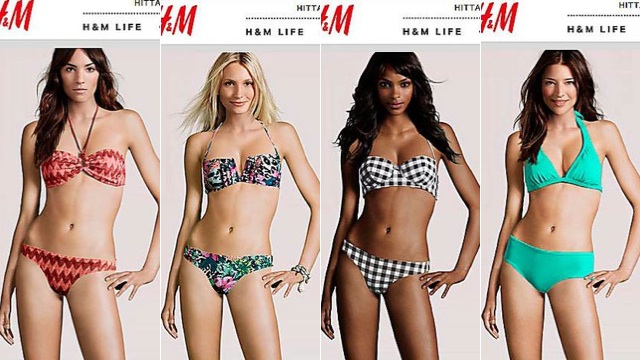h&m’s computer-generated models: what kind of message does this send?
 The bodies of most of the models H&M features on its website are computer-generated and “completely virtual,” the company has admitted. H&M designs a body that can better display clothes made for humans than humans can, then “dresses” it by drawing on its clothes, and digitally pastes on the heads of real women in post-production.
The bodies of most of the models H&M features on its website are computer-generated and “completely virtual,” the company has admitted. H&M designs a body that can better display clothes made for humans than humans can, then “dresses” it by drawing on its clothes, and digitally pastes on the heads of real women in post-production.
– http://jezebel.com/5865114/hm-puts-real-model-heads-on-fake-bodies
When I first read this, I wasn’t sure what to think. After all, it isn’t that that big a step from models whose faces and bodies have been surgically altered to live up to the ridiculous standards set by the fashion industry, to magazine pictures that have been photo-shopped so heavily that the woman is no longer recognisable, to photos that are completely computer generated. It is not that I agree with it at all, but the advertising and fashion industries have never been a moral compass to me.
I talked to some friends about it at lunch the other day. Half were for it and half against – something that really surprised me.
“After all,” one of them argued, “they are selling the clothes. It is about the clothes not the women modelling them. And they designed a body that will show them in the best light.” Even I found myself arguing for that side, if only to play devil’s advocate.
“The food you see sold on television is made out of plasticine,” I declared. “We all know that everything in advertising is fake.”
But when I went home that night, I changed my tune. Because as much as we can say ‘that’s the way that advertising works’, it doesn’t mean that it’s something we should all ignore. I remember being a teenager. And I remember the low self-confidence I had, particularly when it came to physical appearance. And I remember watching advertisements and reading magazines.
Most of all I remember the way that each perfect body made me hate my own imperfect one a little bit more.
The message that H&M are sending is that all women are not good enough. Even the 1% who used to manage to meet the criteria of the fashion industry is no longer enough for them. We have already been bombarding young women with completely unrealistic images, but this takes it to a completely different level. Women are now comparing themselves to computer generated images; they are looking at these as something to aspire to. But they are doomed to failure, because no woman anywhere can live up to that. No one, anywhere, can meet the standard of a computer-generated body.
And why should they, even if they could? What makes these bodies better than any others?
Not only are H&M sending such an unrealistic ideal out into the world, but their idea of a ‘good’ or ‘perfect’ woman’s body is seriously flawed. The computer-generated images not only don’t have one ounce of fat, but they are also free of personality. There are no moles or birthmarks, no cellulite, no uneven skin tone or tan lines- they are free of anything that makes them human.
My body isn’t perfect, but my life is written across it in permanent marker. It is written in the scars from when I ran into a rose bush, it is written in the curves that I earned after a long battle in anorexia, it is written in the beauty marks that dot my legs. We all have the full and beautiful lives that we have led written on our bodies.
But here we are telling young girls that this is not okay. It is not okay to celebrate what makes you different, to see the beauty in individuality. It is not okay to have the small imperfections that make us who we are.
I think the fashion and advertising industries need to take a long hard look at themselves and the damage that they are doing to women’s self-esteem. Because like I said, I remember being a teenager. I remember comparing myself to the women in magazines. And I remember just how that made me feel.
Moreover, those women weren’t computer generated. I can’t even imagine the damage that this will do if H&M’s advertising strategy catches on.
(Image credit: 1.)

